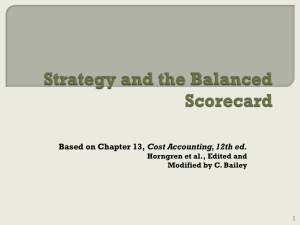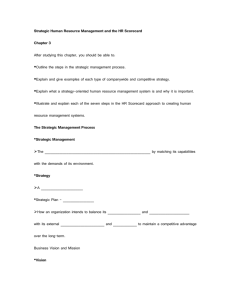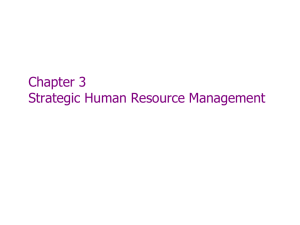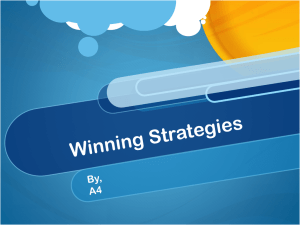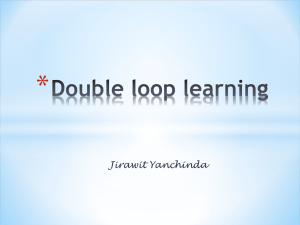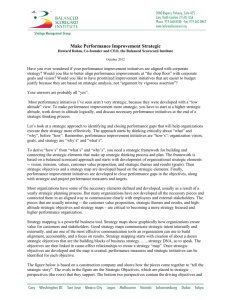on the BalancedScorecard
advertisement
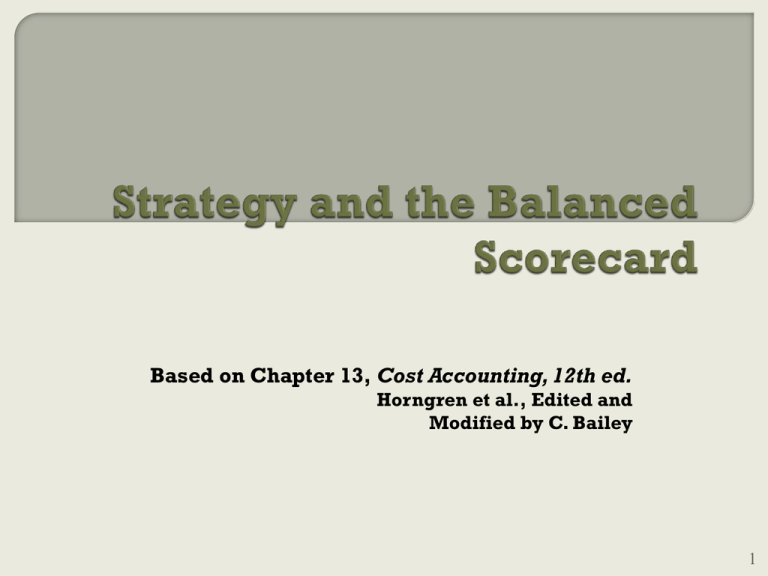
Based on Chapter 13, Cost Accounting, 12th ed. Horngren et al., Edited and Modified by C. Bailey 1 The balanced scorecard translates an organization’s mission and strategy into a comprehensive set of performance measures. Does not focus solely on financial objectives. • highlights nonfinancial objectives that an organization must achieve to meet its [longterm] financial objectives. 2 Attempts to balance • financial and nonfinancial performance measures • short-run and long-run performance in a single report. Why does the balanced scorecard reduce manager’s emphasis on short-run financial performance? 3 Reduces short-term emphasis because: • nonfinancial and operational indicators measure fundamental changes • financial benefits of these changes may not appear in short-run earnings. • nonfinancial measures (leading indicators) signal the prospect of creating economic value in the future. 4 There are four perspectives of the balanced scorecard: 1 Financial perspective 2 Customer perspective 3 Internal business process perspective 4 Learning and growth perspective 5 Evaluates the profitability of the strategy. Focuses on how factors affect income: • Growth (units sold, inputs need) • Price Recovery (higher prices, lower costs) • Productivity (efficiency of resource use) 6 Objective: Increase shareholder value Sample Measures: – Increase in operating income – Revenue growth – Cost reduction is some areas – Return on investment SALES – 7 Identifies the targeted market segment and measures the company’s success in these segments. 8 – – – – Market share Customer satisfaction Customer retention percentage Time taken to fulfill customers requests 9 Focuses on internal operations • Create value for customers • Further the financial perspective by increasing shareholder wealth. Typical Objectives: • Improve manufacturing capability • Reduce delivery time to customers • Meet specified delivery dates 10 Innovation Process Manufacturing capabilities Number of new products or services New product development time Number of new patents – 11 Operations Process Yield Defect rates Time taken to deliver product to customers Percentage of on-time delivery Setup time Manufacturing downtime – 12 Post-sales service Time taken to replace or repair defective products Hours of customer training for using the product – 13 Emphasizes capabilities of • Employees empowerment, training • Info systems Typical Objectives: Develop process skill Empower work force Enhance information system capabilities 14 – – – – – Employee education and skill level Employee satisfaction scores Employee turnover rates Information system availability Percentage of processes with advanced controls 15 1 2 It tells the story of a company’s strategy by articulating a sequence of cause-andeffect relationships. It assists in communicating the strategy to all members of the organization by translating the strategy into a coherent and linked set of measurable operational targets. 16 3 4 5 In for-profit companies, the balanced scorecard places strong emphasis on financial objectives and measures. The scorecard limits the number of measures used by identifying only the most critical ones. The scorecard highlights suboptimal tradeoffs that managers may make. 17 1 2 3 Don’t assume the cause-and-effect linkages to be precise. Don’t seek improvements across all measures all the time. Don’t use only objective measures on the scorecard. 18 4 5 Don’t fail to consider both costs and benefits of initiatives such as spending on information technology and research and development. Don’t ignore nonfinancial measures when evaluating managers and employees. 19 End of BSC Presentation 20
